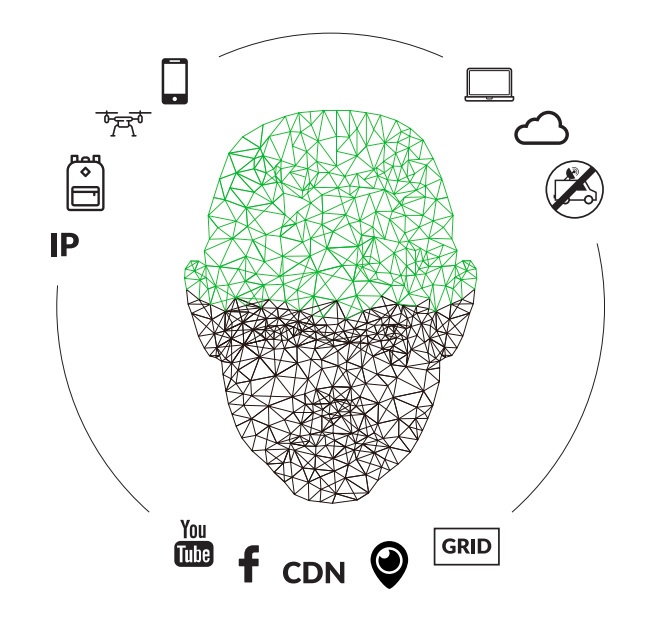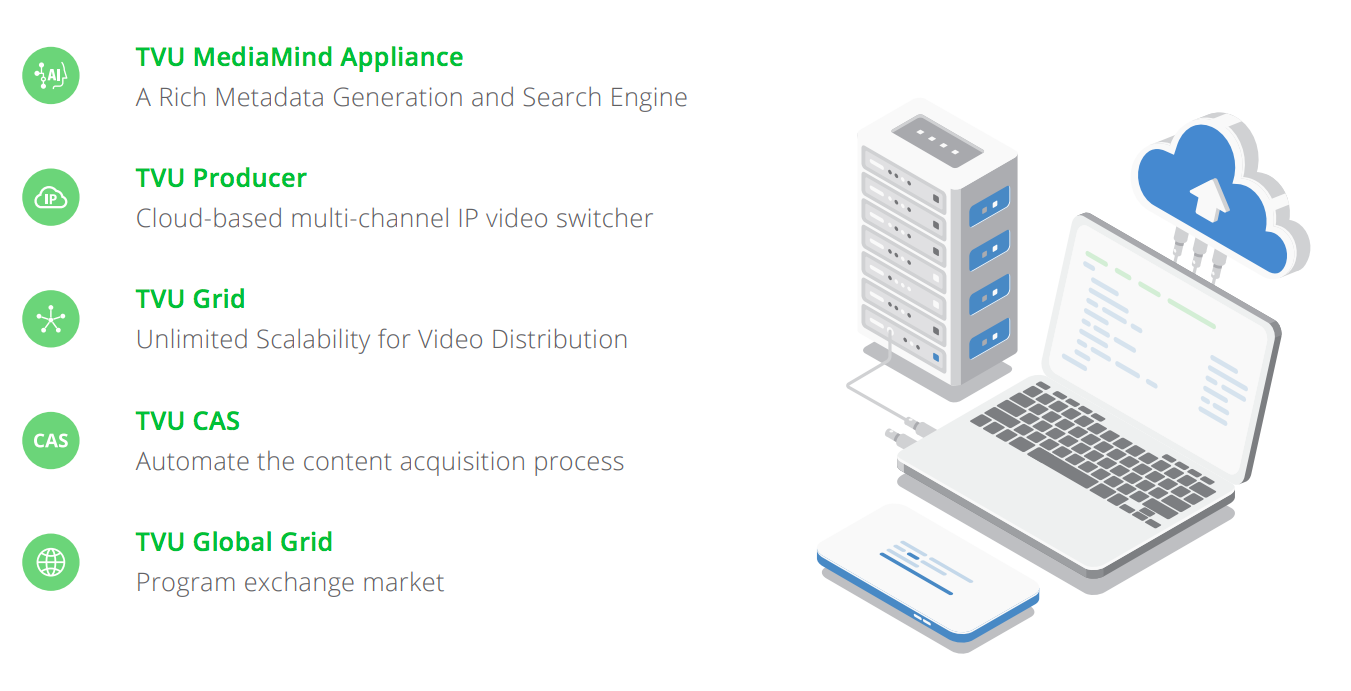Our website's menu is temporarily down for maintenance. In the meantime, please find any info you need through our AI Assistant.

Revolutionizing the Media Supply Chain with AI and Automation
What place does Artificial Intelligence have in the broadcast industry? The rise of mobile and 5G have completely outdated the television set, cable and satellite. The answer lies in a fundamental change of the media supply chain that TVU refers to as Media 4.0. Historically, raw footage has been used for a single program then discarded, never to be used again. But the wide and ever expanding range of available viewing platforms necessitates a more versatile, audience-centric media supply chain.
View Related Products
Artificial Intelligence Revolution
Based on the speculation that human intelligence could be achieved by machines, Artificial Intelligence (AI) was created in the mid-20th century and has come a long way since then, experiencing periods of both immense growth and long stagnation. Technological advancements have given AI more practical real-world uses in recent years, and people across industries look to harness its power not just to do what they already have been doing, but to do it better. This is the idea behind technologies such as the smart personal assistant and robot vacuum, which have both found a place in everyday life.
What place does Artificial Intelligence have in the broadcast industry? To answer that question, we must discuss the direction the industry is moving in today. The rise of mobile and 4G have completely outdated the television set, cable and satellite. Now, video viewers can watch anything anywhere and anytime using the Internet and their mobile devices. This means people are watching on the go, on their phones, via social media platforms and streaming services. As digital viewing means increase, broadcasters need to customize content for their various audiences watching on various platforms. How can they accomplish something so seemingly arduous
The answer lies in a fundamental change of the media supply chain that TVU refers to as Media 4.0. Historically, raw footage has been used for a single program then discarded, never to be used again. But the wide and ever-expanding range of available viewing platforms necessitates a more versatile, audience-centric media supply chain, one that leverages the full potential of raw video material to create personalized content for different types of viewers. To do this, broadcast workflows need to be equipped to broaden their focus, and, as it turns out, Artificial Intelligence is a crucial part of this revolution.

What TVU MediaMind Means for Broadcast
By assigning certain people and equipment to certain stories, indexing video with metadata and automatically and simultaneously sending it to a number of destinations, TVU MediaMind keeps the focus on the content and its viewers at every step of the process, from acquisition to distribution. It allows broadcasters to take the multi-platform approach to production that today’s trends require of them. Whereas once, most raw footage was thrown out as it moved through the production process, now all acquired material can be made useful through AI-generated metadata and the ability to find and reuse material based on that data.
With this technology, broadcasters can envision and achieve the telling of hundreds of stories to any number of audiences, relying on the power of automated processes to intelligently choose the assets appropriate for a certain story and craft that story to send to a targeted audience. TVU MediaMind is a transformation of the media supply chain platform, one that empowers video content by making it more meaningfully storable and repurposable and puts the needs and expectations of viewers first.
Introducing TVU MediaMind
TVU MediaMind is the integrated and automated workflow solution for acquiring, indexing, producing and distributing live video via the Cloud. It is a media supply chain platform that uses Artificial Intelligence among other powerful technologies to revolutionize production and consumption of content by archiving raw footage in such a way that it can be easily and efficiently repurposed.
Artificial Intelligence and Metadata
MediaMind relies on Artificial Intelligence to tag video assets with important information. AI can recognize individuals captured in video footage. That information is visible via the MediaMind web interface, which provides users with organized data categorized by identified person. In addition, AI can recognize speech. Users can find an entire transcription of what is said in every video asset in real time on the web interface. Artificial Intelligence is key to making all content repurposable, as it generates metadata, which serves as the basis for asset organization and classification, which is required for search and reuse.
Search
MediaMind’s search engine can locate a particular asset right down to the exact frame based on a search for particular locations, people and words. Through natural language search, MediaMind works to further guarantee the accuracy of search results by allowing users to search in a way that reflects regular spoken language. The search engine generates time-coded results. Users can even search through video content for people whose names are not recorded in the system. The solution allows users to upload photos of the people they are looking for to the web interface, and can then identify these faces in its stored video assets.
Automation and Real-Time Functionality
MediaMind aims to simplify the journey from acquisition to distribution as much as possible. Automated story assignment and automated metadata tagging remove the need for any time-consuming manual labor, and real-time indexing and real-time search allow broadcasters to locate and use an asset as soon as it is available, saving them a great deal of time and effort. Additionally, MediaMind provides real-time previews of content, which can be taken and edited in real-time so that broadcasters do not need to wait to start on production.
Workflow
TVU MediaMind runs on TVU Servers that receive and decode video content from any IP-based video source or TVU transmitters. There are multiple hardware configurations to suit various needs; servers are available as 1RU or come in half size, with the option to support dual outputs and dual power supplies. TVU MediaMind works with TVU Contribution Automation (CAS) to acquire live video content for indexing. CAS automatically assigns people and equipment such as TVU One and TVU Anywhere to a certain story to streamline the acquisition process. Captured footage is indexed down to the exact frame in real time thanks to Artificial Intelligence, which is capable of speech and face recognition. Content is then archived, able to be referenced and used via the real-time MediaMind search engine. The MediaMind search engine can work with content received by tens of thousands of TVU MediaMind servers. Multiple other TVU products work in tandem with TVU MediaMind. For cloud-based remote production, MediaMind is compatible with TVU Producer, TVU Remote Production System and TVU Timelock. The Server can send video content to a third party website, CDN, Facebook Live or up to six remote locations. A MediaMind server can also distribute video on a global scale if enabled with TVU Grid. Content flowing through MediaMind can be monitored and managed using a web browser interface, which also displays metadata.
Conclusion
TVU MediaMind is a workflow solution that takes the production process to the next level through Artificial Intelligence, automation and real-time elements. Instead of treating production as a series of individual parts, TVU MediaMind ties those parts together by putting consumers at the center of the workflow with Media 4.0. Concerns around the growing use and influence of AI may include the issue of the role of human talent. As machines become powerful enough to take over for people in certain tasks, what need is there for human effort in any step of the content creation process? As stated in FEED Magazine’s article, “The AI Revolution Will Be Televised,” TVU Networks’ vision for TVU MediaMind and AI is that these tools will streamline previously manual processes and provide important information to humans, allowing them to exercise creativity and innovation as they look for the best ways to tell stories to their audiences, create opportunity for growth and stay on top of today’s trends.